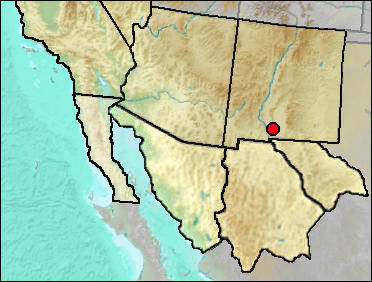 Age. Mid-/Late Wisconsin/Holocene. Van Devender
and Spaulding (1979) list one date on sloth dung as 11,330 ± 370 BP. Thompson et
al. (1980) list three dates for sloth dung, including that above; others are 12330
± 190 and 12430 ± 250. They also list dates on Gopherus scutes and
bone (11,280 to 12,520) and dates for packrat middens in the cave (11,850 to
31,250).
Age. Mid-/Late Wisconsin/Holocene. Van Devender
and Spaulding (1979) list one date on sloth dung as 11,330 ± 370 BP. Thompson et
al. (1980) list three dates for sloth dung, including that above; others are 12330
± 190 and 12430 ± 250. They also list dates on Gopherus scutes and
bone (11,280 to 12,520) and dates for packrat middens in the cave (11,850 to
31,250).
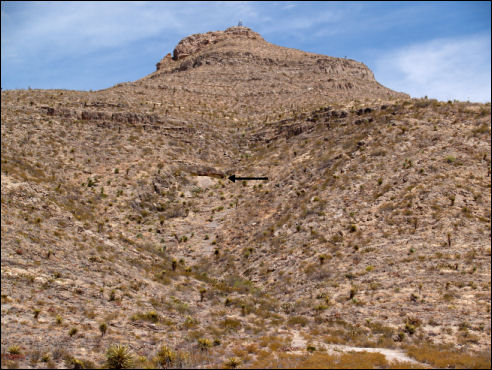
This is a rock shelter on the side of Bishop's Cap (also known as Pyramid Peak), a limestone outlier of the Organ Mountains. The shelter is at an elevation of about 4976 ft and faces somewhat south of west (Fig. 1).
Fig. 1. View of Bishop's Cap and Shelter Cave (arrow). The light patch to the left of the arrow is spoil from the shelter. Photograph by A. H. Harris.
Originally excavated by LACM in ca. 1929 (LACMVP 1010). Brattstrom (1964): Specimens collected from talus, fill, or other areas are labeled 1010 Dump or 1010D. Specimens collected by Conkling are labeled C 1010. Cave was excavated in 5-foot sections. Brattstrom (1964): Two profiles in original field notes. One in Sec. S-5-7, from bottom to top: rock bottom of cave, 5" angular frags., 8" smooth concretionary limestone fragments mixed with brown dust, 6" ash mixed with angular fragments, 10" of layered gray (volcanic?) ash grading into a layer of brown, 4" of hard burned guano, 4" of unconsolidated bat guano, top. Most bones found in brown and gray ash. Another section 53" thick, from bottom up: floor of cave, 17" broken concretionary limestone fragments, 16" of brown ash, 12" of gray layered ash grading into the brown below it, 8" of bat guano, top. Brattstrom (1964:95): Quoting from original field notes: " 'Sloth in place, S-5-4 in upper guano layer and in direct association with bits of knots of vegetative material,' 'S-6-5, sloth bone in upper yellow layer,' 'Mummified rat and snake on top of rocks in bat guano,' 'S-5-6, S-5-5, horse jaws in brown ash,' 'S-5-6, sloth skull fragment in gray ash below overhanging rock. In same section above rock was an indian grindstone,' 'S-4-7, beads and sandal found beneath guano layer and also below overhanging rock,' 'S-4-9, badger and deer skulls in gray ash.'" Brattstrom (1965) noted that many of the tortoise (Gopherus) bones were burned.
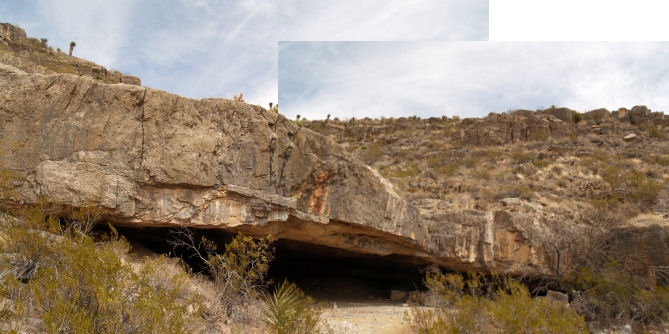

Fig. 2. Composite photograph of Shelter Cave from the exterior, with a slight mismatch (a sharp drop-off behind the camera prevented a more distant shot). Photographs by A. H. Harris.
Fig. 3. View from within Shelter Cave. The green in the middle background is the Rio Grande Valley; dimly visible on the horizon in the far distance are the East Portillo Mountains and Mount Riley. Composite photograph by A. H. Harris.
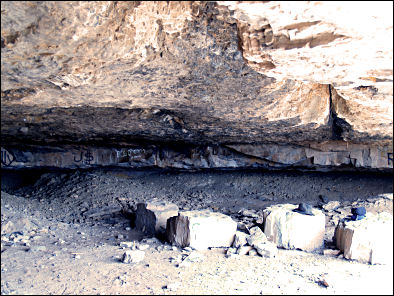
The site has been visited several times by scientists after the original excavation, with a few items of interest salvaged. A few fossils were collected by UTEP from a vertical fissure. A thin layer of apparently undisturbed sediment occurred on a narrow shelf and included Microtus cf. montanus (Smartt 1977). Other recoveries include Notiosorex, Gopherus, Neotoma cinerea, Equus, and Stockoceros, along with some snake material. A visit in March of 2009 shows considerable activity by humans that have churned much of the deposits remaining in the shelter.
Fig. 4. View of the interior of Shelter Cave from near the entrance. Photograph by A. H. Harris.
Fosberg (1936) lists plants identified from Shelter Cave deposits, but without provenience data. His conclusion is that the flora of the region at the time the plants were deposited was that of an arid land similar to that of the present. My own interpretation is that quite possibly most or all of the plant remains are Holocene. Fosberg also mentions that there are coprolites of either sloth or horse. Thompson et al. (1980) point out that pre-full-glacial middens here are more mesic than the terminal Pleistocene ones (that lack oak and, mostly, pinyon).
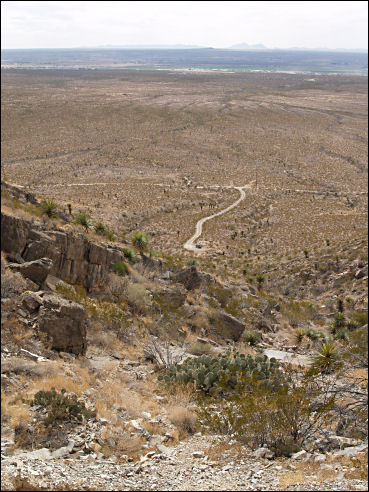
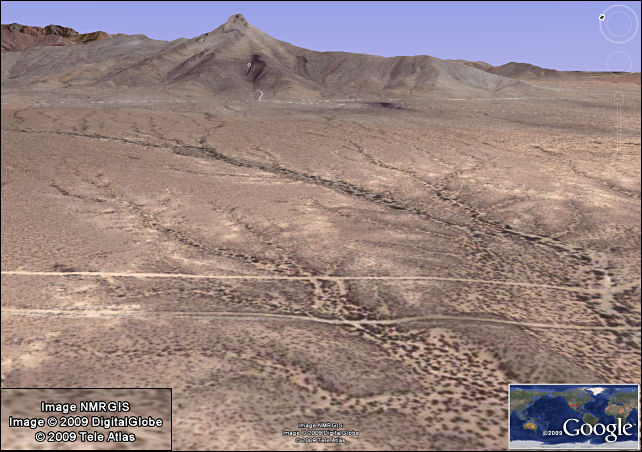
Fig. 5 (left). View down slope to the west from Shelter Cave. Photograph by A. H. Harris.
Fig. 6 (right). Bishop's Cap with the position of Shelter Cave (white circle) as seen from approximately southwest. Google Earth image.
Scaphiopus couchii—Couch's Spadefoot (Brattstrom 1964: cf.)
Lithobates pipiens—Leopard Frog (Brattstrom 1964: cf.)
Gopherus morafkai—Morafka's Tortoise (Van Devender et al. 1976)
Plestiodon obsoletus—Great Plains Skink (Brattstrom 1964)
Phrynosoma cornutum—Texas Horned Lizard (Brattstrom 1964)
Crotaphytus collaris—Eastern Collared Lizard (Brattstrom 1964)
Coluber constrictor—Racer (Brattstrom 1964)
Masticophis flagellum—Coachwhip (Brattstrom 1964)
Lampropeltis getula—Common Kingsnake (Brattstrom 1964)
Pituophis catenifer—Gopher Snake (Brattstrom 1964)
Bogertophis subocularis—Trans-Pecos Rat Snake (Brattstrom 1964)
Trimorphodon vilkinsonii —Chihuahuan Lyre Snake (UTEP)
Crotalus atrox—Western Diamondback Rattlesnake (Brattstrom 1964)
Nothrotheriops shastensis—Shasta Ground Sloth (Harris 1993c)
Tamias sp.—Chipmunk UTEP
Geomyidae—Pocket Gopher (Harris 1993c: ?)
Microtus montanus—Montane Vole (Smartt 1977: cf.)
Neotoma cinerea—Bushy-tailed Woodrat (Harris 1993c)
Lepus californicus—Black-tailed Jackrabbit (Harris 1993c)
Sylvilagus audubonii—Desert Cottontail UTEP
Notiosorex harrisi—Harris' Shrew (Carraway 2010)
Lynx rufus—Bobcat (Harris 1993c)
Canis latrans—Coyote (Harris 1993c)
Urocyon/Vulpes—Fox (Harris 1985)
Taxidea taxus—American Badger (Harris 1993c)
Spilogale gracilis—Western Spotted Skunk (Hall 1936)
Spilogale leucoparia
Mephitis mephitis—Striped Skunk (Harris 1993c)
Equus conversidens—Mexican Horse (this volume)
Equus scotti—Scott's Horse (Harris data: cf.)
Camelops sp.—American Camel (Stock 1932)
Odocoileus sp.—Deer (Harris 1993c)
Capromeryx sp.—Miniature Pronghorn (Harris 1993c)
Stockoceros conklingi—Stock's Pronghorn (Stock 1930)
Ovis canadensis—Bighorn Sheep (Harris 1993c)
Anabernicula gracilenta—Graceful Pygmy Goose (Howard 1964)
Anser albifrons—Greater White-fronted Goose Howard and Miller 1933
(?)
Anas acuta—Northern Pintail (Howard and Miller 1933)
Anas crecca—Blue-winged Teal (Howard and Miller 1933)
Centrocercus urophasianus—Greater Sagebrush-Grouse (Howard and Miller
1933)
Meleagris crassipes—Big-foot Turkey (Rea 1980)
Callipepla squamata—Scaled Quail (Howard and Miller 1933)
Callipepla sp.—Crested Quail (not C. squamata)(Howard and Miller
1933)
Oreortyx pictus—Mountain Quail (Howard and Miller 1933)
Cathartes aura—Turkey Vulture (Howard and Miller 1933)
Breagyps clarki—Clark's Condor (Howard 1971)
Accipiter striatus—Sharp-shinned Hawk (Howard and Miller 1933)
Aquila chrysaetos—Golden Eagle (Howard and Miller 1933)
Buteo albonotatus—Zone-tailed Hawk (Howard and Miller 1933) (?)
Buteo jamaicensis—Red-tailed Hawk (Howard and Miller 1933)
Buteo swainsoni—Swainson's Hawk (Howard and Miller 1933)
Buteogallus fragilis—Fragile Eagle (Howard and Miller 1933)
Caracara cheriway—Crested Caracara (Howard and Miller 1933)
Falco peregrinus—Peregrine Falcon (Howard and Miller 1933)
Falco sparverius—American Kestrel (Howard and Miller 1933)
Fulica americana—American Coot (Howard and Miller 1933)
Porzana carolina—Sora (Howard and Miller 1933)
Larus sp.—Seagull (Howard and Miller 1933)
Zenaida macroura—Mourning Dove (Howard and Miller 1933)
Geococcyx californianus conklingi—Conkling's Roadrunner (Howard and
Miller 1933)
Geococcyx californianus californianus—Greater Roadrunner (Howard and
Miller 1933)
Tyto alba—Barn Owl (Howard and Miller 1933)
Aegolius acadicus—Northern Saw-whet Owl (Howard and Miller 1933)
Aegolius funereus—Boreal Owl (Howard and Miller 1933)
Athene cunicularia—Burrowing Owl (Howard and Miller 1933)
Bubo virginianus—Great Horned Owl (Howard and Miller 1933)
Megascopes asio—Eastern Screech-Owl (Howard and Miller 1933)
Aeronautes saxatalis—White-throated Swift (Howard and Miller 1933)
Colaptes auratus—Northern Flicker (Howard and Miller 1933)
Melanerpes formicivorus—Acorn Woodpecker (Howard and Miller 1933)
Sayornis saya—Say's Phoebe (Howard and Miller 1933)
Lanius ludovicianus—Loggerhead Shrike (Howard and Miller 1933)
Corvus corax—Common Raven (Howard and Miller 1933)
Pica hudsonia—Black-billed Magpie (Howard and Miller 1933)
Gymnorhinus cyanocephalus—Pinyon Jay (Howard and Miller 1933)
Eremophila alpestris—Horned Lark (Howard and Miller 1933)
Catherpes mexicanus—Canyon Wren (Howard and Miller 1933)
Salpinctes obsoletus—Rock Wren (Howard and Miller 1933)
Turdus migratorius—American Robin (Howard and Miller 1933)
Sialia sp.—Bluebird (Howard and Miller 1933)
Toxostoma sp.—Thrasher (Howard and Miller 1933)
Oreoscoptes montanus—Sage Thrasher (Howard and Miller 1933)
Amphispiza bilineata— (Howard and Miller 1933) (very recently
entombed)
Calamospiza melanocorys—Lark Bunting (Howard and Miller 1933)
Pipilo maculata—Spotted Towhee (Howard and Miller 1933)
Melozone fuscus—Brown Towhee (Howard and Miller 1933)
Pipilo fuscus
Molothrus ater—Brown-headed Cowbird (Howard and Miller 1933)
†Pyelorhamphus molothroides—Thick-billed Cowbird (Howard and Miller
1933)
Carpodacus mexicanus—House Finch (Howard and Miller 1933)
Literature. Brattstrom 1961, 1964; Carraway 2010; Fosberg 1936; Hall 1936; Harris 1977, 1985a, 1993c; Harris and Crews 1983; Howard 1971; Howard and Miller 1933; Rea 1980; Smartt 1977; Stock 1930, 1932, 1936b; Thompson et al. 1980; Van Devender and Spaulding 1979; Van Devender et al. 1976.
Last Update: 30 Jul 2013